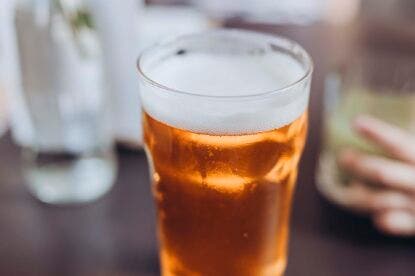The term “sparkler” may invoke ideas of fun and frivolity, but the small plastic nozzle used to aerate cask-conditioned ale is divisive in Great Britain, a country that loves to argue about everything from sports teams and regional bread roll names to Brexit.
Pro-sparkler advocates say they impart a creamy, pleasing texture to cask ales, a fundamentally British style whose local esteem is akin to lagers in Germany or Czech pilsner. Those against them tend to be dogged. They believe sparklers “bruise” the beer, knocking out its flavor, aroma and character.
“They remove loads of condition, flavor and aroma from the body into an ‘artificial’ head,” says Caroline Debenham, an Essex-based pub cellar manager and ardent cask beer drinker. “The beer’s head should form from the natural condition.”
The small plastic nozzle used to aerate cask-conditioned ale is divisive in Great Britain, a country that loves to argue about everything from sports teams to Brexit.
This is a key tenet of anti-sparkler theory: the idea is that a well-kept and conditioned beer should have healthy carbonation to form its own frothy head when poured.
So, how does it work, exactly? No bigger than an acorn, a sparkler vaguely resembles a miniature, three-tiered cake. It’s fitted (or not) to the end of the spout of a beer engine, through which beer is pulled from cask to glass.
When fitted, the beer doesn’t flow freely from the end of the spout, but it’s forced through tiny holes in the plastic. This agitates the carbon dioxide in the beer, which results in a thicker, creamier head.
“It seems to be all on appearance, the thick creamy head ‘looks better,’ ” says Debenham. “I have no idea of the science, but a side-by-side taste test shows it clearly. The better alternative is no sparkler.”
Matthew Curtis, cofounder and editor-in-chief at Pellicle Magazine, was anti-sparkler until a particular pint changed his mind.
“Around 2017 or 2018, I had a moment with a pint of Earl Grey IPA in one of my favorite pubs,” he says. “The pint was so powerful and aromatic, with note-perfect carbonation underpinned by a rich, creamy mouthfeel. It was in that moment I realized the sparkler had made the serve. The finger-thick head remained intact for the entire time, and the glass was lined with pleasing lacy foam.”
Curtis maintains that sparklers could never remove the flavor or aroma from cask ales.
“Literally all it does is put a liquid from a bigger hole through several smaller ones,” he says. “It is false, largely, that they are used to knock more condition into flat beer. In terms of physics, the smaller holes [would] surely knock carbonation out of the beer, not increase it.”

Sparklers, and the strong feelings they inspire, are distinctly British, Curtis says.
“I really enjoy the sparkler debate because I think it’s one of the special elements of British beer culture that really sums up the sometimes tribal, regional nature of beer, and how passionate we are about it,” he says.
Many British beer drinkers say the debate is geographic, with the dividing line between the north and south of the country. Debenham, a southerner, says she never encounters sparklers until at least the Midlands, two-plus hours north of London.
Pro-sparkler advocates say they impart a creamy, pleasing texture to cask ales, a fundamentally British style whose local esteem is akin to lagers in Germany or Czech pilsner.
Bill Arnott, the British-born founder of Machine House Brewery in Seattle, shares Debenham’s anti-sparkler stance. One of the few U.S. operations brewing and serving cask beer, Machine House generally doesn’t use sparklers.
“I’m pretty anti-sparkler, as I find it changes your experience of the carbonation, which to me is perfect through a beer engine with no sparkler, or on gravity pour,” he says. “But, we have a couple of blokes from northern England that insist on getting their pint of bitter poured with a sparkler, and since there’s no other cask ale for hundreds of miles, I like to accommodate them.
“Growing up in Norfolk [in the East of England], I never had beer poured with sparklers, and so it’s obviously just what I’m used to,” he says. “Even though I like no sparkler, I imagine if I was at a good pub in the north and everything was poured with a sparkler, I would be quite happy with it. I like that sort of regional specialty and just going with what everyone is having, a ‘when in Rome’ sort of thing.”
The respect for local preference underscores the otherwise hotly contested debate. As much as she dislikes sparklers, Debenham tolerates them when in the north to “avoid hassle.” Curtis accepts that some beers taste better without their use. He cites Harvey’s Sussex Best Bitter as an example, having done side-by-side taste tests.
And, despite being a southerner, this author very much prefers her cask beer sparkled.
“I think the sparkler debate is important though, and I think its continuation is representative of how passionate we are about beer as a nation,” says Curtis. As cask beer’s popularity grows in the U.S., perhaps the debate will spread there, too.
“A lot of the culture when I first came here, where casks were a novelty to put weird infusions in, has faded as appreciation of classic styles done well has grown,” says Arnott, “So, I would say cask beer is in a much better place in the U.S. than it was when I got here 10 years ago.”
Last Updated: May 22, 2023















